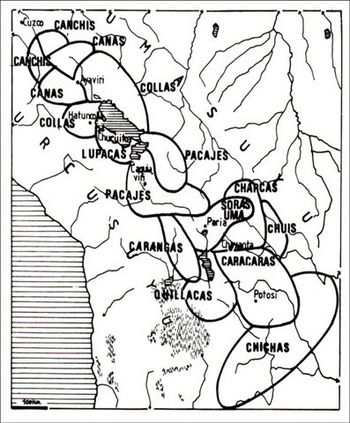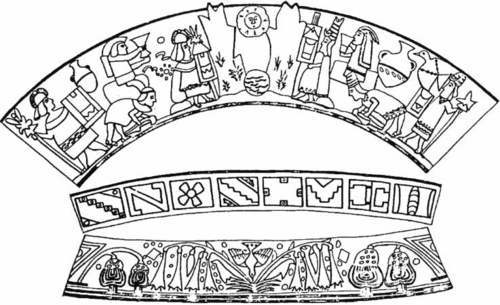Colla Kingdom facts for kids
Quick facts for kids
Colla Kingdom
|
|||||||||
|---|---|---|---|---|---|---|---|---|---|
| c. 1150–c. 1463 | |||||||||

The Colla culture area, in the northern Titicaca Basin, along with other altiplano polities.
|
|||||||||
| Capital | Hatunqulla (Urcosuyu), Azángaro (Umasuyu) |
||||||||
| Common languages | Quechua, Aymara |
||||||||
| Other languages | Puquina, Uru |
||||||||
| Government | Diarchy | ||||||||
| Historical era | Late Intermediate | ||||||||
|
• Established
|
c. 1150 | ||||||||
|
• Conquered by the Inca Empire under Pachacuti
|
c. 1463 | ||||||||
|
• Revolt crushed by Topa Inca Yupanqui
|
c. 1483 | ||||||||
|
|||||||||
The Colla Kingdom, also known as Qolla or Qulla, was an important kingdom in ancient South America. It was located near Lake Titicaca in the northwestern part of the Altiplano, a high plateau region. The Colla Kingdom was one of several Aymara kingdoms that appeared after the fall of the powerful Tiwanaku civilization.
Around the mid-1400s, the Colla Kingdom controlled a very large area. It was one of the biggest Aymara kingdoms. Later, the 9th Sapa Inca (the emperor of the Inca Empire), named Pachacuti, conquered the Colla Kingdom and other groups in the region.
The Inca Empire later called a much larger area "Qullasuyo" or "Colla Region." This was because the Colla Kingdom was the most important of the Aymara kingdoms to them. Even though there were many Aymara groups, the Incas used the name "Colla" for all of them because of the Colla Kingdom's influence.
How the Colla Kingdom Was Organized
The Qolla people divided their kingdom into two main parts, called Suyu (which means "region" in their languages). These were:
- Urcosuyu: This name meant "male" or "fire."
- Umasuyu: This name meant "female" or "water."
The main capital city of the Colla Kingdom was Hatunqulla. Its name means "Colla, the Great." This city was located about 34 kilometers (21 miles) north of the modern city of Puno. Hatunqulla was in the Urcosuyu region and was ruled by a family called the Zapanas.
The capital of the Umasuyu region was Azángaro. However, Azángaro was still under the rule of Hatunqulla. This way of organizing a government with two parts, where one part was still more important, was common in ancient Andean civilizations. For example, the Inca Empire also divided its society into "Hanan" (Upper) and "Hurin" (Lower) sections.
The Urcosuyu region included towns like Hatuncolla, Juliaca, Lampa, and Paucarcolla. The Umasuyu region had towns such as Azangaro, Ayaviri, Huancané, and Copacabana.
The Qollas of Umasuyu also controlled the famous Titicaca Island in Lake Titicaca. Old records say that this island was once home to Qolla people. It was also an important religious site for the Puquina Qollas and Uro Qollas.
Within the Colla Kingdom, there were three main groups of people:
- Aymara
- Puquina
- Uro
A historian named Felipe Guaman Poma de Ayala clearly identified these groups. He called the Aymaras simply "Qolla," the Puquinas "Puquina Qolla," and the Uros "Uro Qolla." Some Uros spoke the Puquina language, while others spoke a language called Uruquilla.
The Inca Conquest
About ten years after he became emperor, Pachacuti began to expand the Inca Empire. He sent his soldiers, led by Apo Conde Mayta, towards the border of the Colla Kingdom. The Colla Kingdom was very powerful, and its leader was named Chuchi Capac, also known as Qulla Capac. Pachacuti soon joined his troops and marched into the Colla lands, reaching the Vilcanota River.
Qulla Capac knew the Incas were invading his territory. He gathered his army and went to the town of Ayaviri to wait for them. When Pachacuti arrived, he realized that the Collas would not surrender peacefully. A long and fierce battle began.
As the fight continued, the Collas started to lose. They retreated to Pucara, which was a strong mountain fort. The Incas followed them. At Pucara, a second battle took place. The Incas won again, and they even captured the powerful Qulla Capac. After securing his victory, Pachacuti went to Hatunqulla, the home of the defeated Colla leader. He stayed there until all the towns that had been under Colla rule came to accept Inca authority.
See also
 In Spanish: Reino colla para niños
In Spanish: Reino colla para niños


